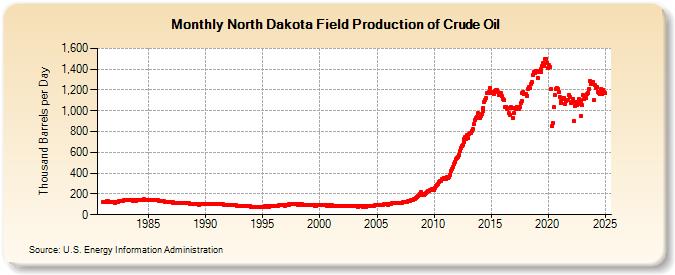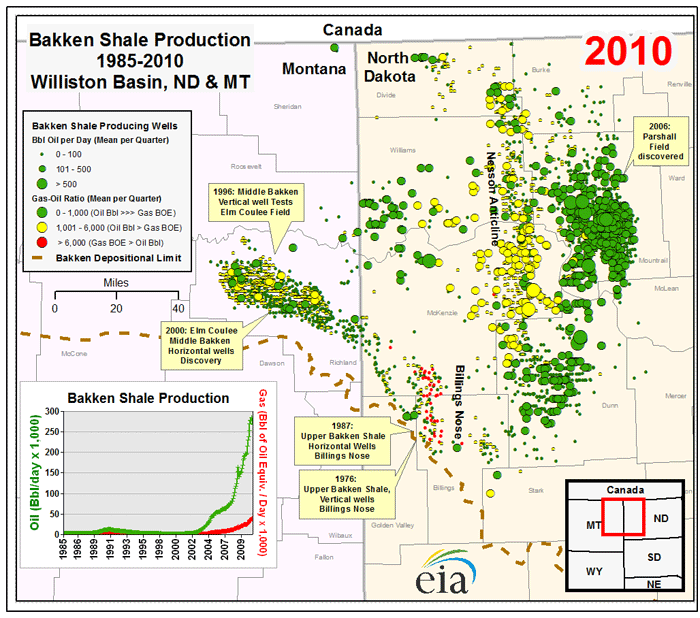
Posted on 11/16/2011 7:16:34 AM PST by thackney
The cold autumn wind whipping North Dakota’s Badlands carries a new seasonal risk to the oil markets: an abrupt slowdown in the breakneck expansion of the Bakken oil shale bonanza.
Fierce winters — where temperatures drop as low as minus 40 degrees Fahrenheit (-40 degree Celsius) and snow piles up to 107 inches (2.7 meters) — have in recent years impeded work on oil wells and slowed traffic across the white prairie, halting a relentless oil production boom that has upended the market.
The volumes are small but important: if fewer barrels of new oil are added to the market, the price pressure on Midwest crude oil will come off. At least during the winter, U.S. crude may rebound from its record discount against global benchmark Brent, which was brought on by the absence of pipelines that pump the crude to Gulf Coast refineries.
And while seasonality is nothing new to oil traders, its emergence in North Dakota is another sign of how the country’s rapidly emerging “tight oil” bounty is introducing major changes to the most cash-flush commodity market, even as it reverses what had been an inexorable decline in onshore output.
The National Weather Service has predicted another unusually harsh winter this year. Oil production in North Dakota is expected to reach a record high of 475,000 bpd in October, then level off at lower rates for six months, says Lynn Helms, director of the state department of Mineral Resources, which regulates oil producers.
“Winter is going to flatten the curve — instead of growing at 20,000 barrels-per-day every month, production will level off or rise very slowly in the coming months,” he told Reuters. Output has doubled in just three years.
Drillers say winter weather forces them to reduce work by 10 to 15 per cent on hydraulic fracturing, the controversial technology that has allowed companies to tap into some 3.65 billion barrels of reserves in the unconventional shale play.
Transport firms say fierce snowstorms and high winds along open roads also slow or halt traffic, preventing trucks from delivering equipment and rigs to drill sites or hauling out crude oil away to refineries and rail hubs.
Operators say they’re getting smarter each year, finding new ways to minimize the disruption to wintertime operations.
Meanwhile, the impact for markets grows. North Dakota’s oil output, already poised to overtake California as the nation’s third largest oil producing state, reached above 464,000 bpd in September, which met 2.4 per cent of U.S. consumption.
BITTER WINTER, WET SPRING
The oil market is accustomed to seasonal shifts in supply and demand. Oil demand dips in the autumn and spring, North Sea oil production falls during summer maintenance and gasoline consumption soars during the U.S. summer. One oilfield in Russia’s far east used to shut completely during winter.
Last year, when North Dakota was gripped by one of the coldest and wettest Decembers on record, some 13,000 barrels-per-day (bpd) of production was forced off-line and leaving over 1 million barrels of oil uncollected in wells.
In February, producers were forced to idle more than 800 wells, the largest such number in nine years. More than 50 rigs have been added to the prairie’s oilfields since last year.
The bitter winter lasted later than usual, with temperatures below freezing in March. But the problems did not end when the snow thawed in April. Floods inundated the Missouri River and cut off traffic throughout the state, dragging down production by 2.5 per cent for the month.
Over the past five years, North Dakota’s crude oil output dipped an average of 4,900 bpd in December and January. This compares with a five-year average increase of 7,726 bpd in June.
The largest drops were recorded in the 2008-2009 winter, when blizzards put a strain on production as did low prices when U.S. crude fell below $40 a barrel. The state’s output fell 7.25 per cent that January.
Graphic: http://link.reuters.com/qyb94s
THE CRUELEST MONTHS?
When the weather unleashes its fury, companies are forced to idle wells and leave barrels of oil stranded, according to Ron Ness, director of the North Dakota Petroleum Council, which represents state producers.
“Everything just takes longer and costs more,” Ness added.
Continental Resources, one of the largest producers in the Bakken prospect both in North Dakota and Montana, says winter power outages and spring rains slowed well completions — preparations to pump out oil — and hampered the free movement of rigs in the past few years.
Texas-based oilfield operator Halliburton says it completes 10 to 15 per cent fewer fracking jobs in the height of winter in North Dakota since operations take more time. The company says it takes more time to clear out snow or frack wells, a process that involves pumping chemical-laced water and sand into wells to free trapped oil.
“In some places it could take trucks a week to get back out to wells,” said Tom Blazer, vice-president of the North Dakota Motor Carriers Association, adding last winter was among the worst for truckers.
Spring thaw can be a disaster after a snowy winter in the Great Plains. Road restrictions were put in place last year after snow melted in May and led to a 113-year record flood along the Missouri River and its tributaries.
In June, five drilling rigs were stuck and out of use, and drillers shut in 45 wells and 500 more awaited fracking services in vain. The floods briefly shut 50,000 bpd of rail transportation and access was cut off to a terminal in Minot, North Dakota.
Output then jumped in the summer, by up to 40,000 bpd between June and July as companies sped up fracking work.
Every year, operators take some measures to avert severe production losses. They schedule heavier drilling work in the fall, undertake major winterization projects and preheat fracking fluids in winter. Continental Resources built pipelines and storage tanks for crude and fracking fluids to prepare for the winter ahead.
Such arrangements sent North Dakota’s rig count to a record high of nearly 200 in October, according to state regulators.
“We don’t know what weather conditions will bring but operators always make adjustments based on what they learned last session. So I expect impacts to be less than last year,” Ness with the state Petroleum Council says.
Drilling engineers should be prepared for extreme cold. The climate of North Dakota was not unknown. We’ve been drilling and pumping oil in the frigid wilderness of northern Alaska and Prudhoe Bay for 40 years without major issues.
Somebody 'splain to this writer what "inexorable" means.
Agreed, I’ve worked on the Alaskan North Slope.
thanks for your posts, as always
shouldn’t NPR make documentary about the positive effect of global warming here?
Ditto - I’m sure winter has some impact, but good grief, the author seems to have forgotten Alaska existed.
I recently located a really good job for my brother in law in the the oil industry as a welder in North Dakota. The pay was great but, being as how he lives in Florida, he decided to wait on the job until next Spring. Going from balmy Florida to the arctic blasts of North Dakota can be brutal.
KOG is one of the companies doing business there.
Not sure this is much of a story. As has been said we pump oil in Alaska, and the Russians also pump oil in Siberia.
He may want to look at South Texas for the winter work.
Eagle Ford Shale is doing the same type of work and struggling to find enough people.

There’s a series running on the Science Channel called “Cold Diggers”, it was on yesterday again. They follow MGM Energy and Nabors Drilling as they drill in the Yukon, well above the Artic Circle and Northern Alberta. It’s a 4 or 5 part series.
If you can drill there as they say. ND ain’t sh%t.
I don't think they have to use fracking in Alaska.
With oil shale the water/acetic acid/sand/glass beads etc have to be trucked in to the well head....and when the well is put in production a lot of it comes back out, which is then trucked back to re-cycling facility.
Awesome map!
Better bring a trailer and find a place to hook up also. Finding a place to hook up in the Eagle Ford play is hard to do. Heard that landowners are selling RV hookups for a price.
.....obviously an unrequited “peak oil” fan.
Disclaimer: Opinions posted on Free Republic are those of the individual posters and do not necessarily represent the opinion of Free Republic or its management. All materials posted herein are protected by copyright law and the exemption for fair use of copyrighted works.